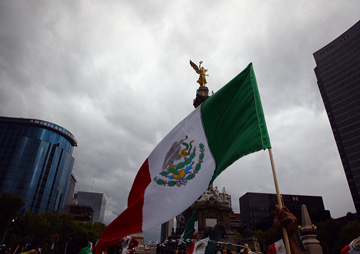More Mexican Immigrants Are Returning to Mexico Than Coming to the U.S.
Shut up about your dumb wall already. Esparta Palma (CC BY 2.0)
Esparta Palma (CC BY 2.0)
By Kali Holloway / AlterNet
This piece originally ran on AlterNet.
If you listen to Donald Trump and his legions of supporters—a task you undertake at your own peril—you will inevitably hear about hordes of invading Mexicans arriving in the United States daily, and the border wall the billionaire presidential candidate has proposed to keep them out. Variously described by Trump as a “gorgeous wall,” a “great, great wall,” and the “greatest wall that you’ve ever seen,” this magnificent would-be eighth wonder of the modern world has become a cornerstone of the GOP presidential contender’s campaign, a majestic concrete testament to America’s renewed Trumpian greatness.
Because he has thought of everything, Trump says there will be “a big, fat beautiful door right in the middle of the wall” to let back in the “good ones,” which is racist-speak for Mexicans who are “not like the others.” If any of this were based in reality and not bigoted delusion, the wall would also include a jaw-droppingly handsome doorstop to keep that breathtakingly dreamy entryway propped open all the time. Because right now, for the first time since the 1940s, more Mexicans are actually leaving the United States than are arriving.
Late last year, the Pew Research Center reported findings indicating that between 2009 and 2014, approximately 870,000 Mexican nationals arrived in the states. During that same time frame, an estimated “1 million Mexicans and their families (including U.S.-born children) left the U.S. for Mexico.” The number of departures outpaced arrivals by roughly 130,000, leaving the U.S. with a negative net flow of immigrants from Mexico arriving on its soil. With that, there’s been a resulting drop in the number of undocumented Mexican migrants living in the U.S., with the population decreasing by about one million from 2007 to 2014.
It would be probably be helpful if these facts and figures received a little more coverage at this moment, as our electoral season immigration debate is increasingly fueled by hysteria instead of facts.
Though President Obama has rightfully earned the moniker “deporter in chief,” the directional shift in Mexico-to-U.S. immigration is less the result of removals than changing views about this country, a desire to reunify with family and increases in migration by other groups. Pew cites sluggish Great Recession economic recovery, and correlating shrinkage in unskilled labor market, as a demotivating factor for Mexican migration and a possible reason why some migrants have returned home. While the ramping up of immigration laws, “particularly at the U.S.-Mexico border,” is a likely contributor to the drop-off in migration numbers, for many Mexicans, dwindling opportunities in America may be making the treacherous northward journey simply not worth the risk.
In the over 60 years Pew has pored over border patrol data, 2014 was the first time “more non-Mexicans than Mexicans were apprehended at U.S. borders…by the Border Patrol.” The downturn in Mexican migration attempts since the turn of the century has been fairly huge. In 2000, 1.6 million Mexican nationals trying to enter the country were apprehended at the border. In fiscal year 2014, that figure had plummeted to 229,00. Post-Great Recession America is a place fewer Mexican migrants are willing to undertake the journey to reach.
With decreasing belief in the accessibility of the American Dream, an increasing number of Mexican citizens are less convinced the grass to the north is greener. This is, perhaps, based on more widespread knowledge of the difficult lives migrants encounter, as relayed by nearly four generations of Mexican immigrants. Millions of Mexicans who have come to the U.S. over the past few decades made incredible personal sacrifices to get here, beginning with a dangerous, not infrequently lethal desert journey, followed by attempts to make a life here without cherished friends and loved ones around. Social isolation, alienation and loneliness—and encounters with xenophobia and racism, which have crept up since these surveys were conducted—can take a toll not always or fully remedied by money earned through backbreaking labor.
Maybe that explains why a 2014 Mexican Survey of Demographic Dynamics cited by Pew found 61 percent of migrants said their primary reason for returning home was to reconnect with family. That’s a far greater number than the mere 14 percent who reported they’d been deported. For the most part, migrants returning to Mexico from the U.S. are doing so of their own volition. Pew found that while 45 percent of Mexicans adults surveyed said life is better in U.S., one-third believe that “those who move to the U.S. lead a life that is equivalent to that in Mexico”—10 percent more than those who felt that way in 2007.
While the number of immigrants from Mexico has been trending downward, Pew notes that there has been a concurrent rise in unaccompanied children from El Salvador, Guatemala and Honduras arriving at the border. Any thoughtful discussion of the situation would necessarily include a look at the complex contributing geopolitical issues, including the impact of the U.S.’s political interventionism and the country’s failed war on drugs in places far beyond our own borders. There’s also the matter of immigration patterns changing, as they tend to do over time. Pew notes that “the U.S. Census Bureau recently reported that China overtook Mexico in 2013 as the leading country for new immigrants.” There are conflicting reports around this fact, including by Pew’s own tally, though the organization definitively states, “[r]egardless of the exact number of new immigrants from each country arriving in the U.S. each year, the trends are clear: Over the past decade, immigration from China and India to the U.S. has increased steadily, while immigration from Mexico has declined sharply.”
Still, the wall along the southern border remains a favored aspect of Trump’s policy platform among his adherents. A Pew survey released earlier this year found a staggering “84 percent of Republican and Republican-leaning registered voters who support Trump for the GOP nomination favor building a border wall.” Among Republican voters in general, 63 percent back the proposition. Just 13 percent of Democrats think this the wall is a good idea, while 84 percent are opposed to it. That’s closer in alignment with the feelings of Americans overall, 62 percent of whom say they are against the wall.
Amidst all the facts that should be emphasized in any sane conversation about Trump’s border wall, the standout is that there’s no way it will ever be built. The wall that Trump has not yet called “the sexiest thing to happen to border reinforcements” (give it a week) is really a make-up illusion to send his base into a frenzy; a fetish object fantasy for the white, angry, racist, “poorly educated” voters he claims to love so much. Between labor, cost, violations of the law and sheer uselessness, it’s obvious that Trump’s money pit will never become a reality.
Donald Trump may be a fool, but he’s not an idiot, and he knows all this. But he keeps promising a wall that gets bigger and better at every campaign stop. Because he knows his followers don’t really care what he actually does, as long as he tells them what they want to hear, thereby justifying all the terrible things they, and plenty of Americans, think.
Your support matters…Independent journalism is under threat and overshadowed by heavily funded mainstream media.
You can help level the playing field. Become a member.
Your tax-deductible contribution keeps us digging beneath the headlines to give you thought-provoking, investigative reporting and analysis that unearths what's really happening- without compromise.
Give today to support our courageous, independent journalists.









You need to be a supporter to comment.
There are currently no responses to this article.
Be the first to respond.